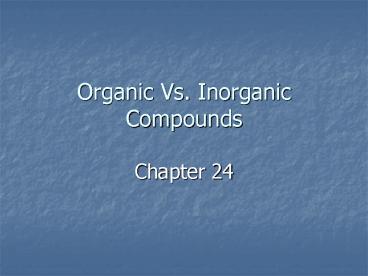Organic Vs. Inorganic Compounds PowerPoint PPT Presentation
1 / 14
Title: Organic Vs. Inorganic Compounds
1
Organic Vs. Inorganic Compounds
- Chapter 24
2
Think About It ?
- How does chemical bonding affect the formation of
simple organic compounds? - In what way do biological polymers have a role in
living things?
3
Standard PS-3
- 3.2 Infer the practical applications of organic
and inorganic substances on the basis of their
chemical and physical properties.
4
Organic Substances
- Organic Chemistry study of carbon-containing
compounds - An organic compound
- Usually composed of carbon and hydrogen
- Some with oxygen, nitrogen, halogens, even sulfur
- Carbon can form 4 covalent bonds (also bonds
with itself in chains, branched chains, or rings) - Can form strong single, double, or triple bonds
- 16 million compounds known
5
Organic Substances
- Hydrocarbons- Produce more than 90 of energy we
use - Composed of carbon hydrogen
- CH4 methane
- C3H8 propane
- C2H6 ethane
- Saturated Hydrocarbon contains all of the
hydrogen atoms it can hold
6
Organic compounds continued
- Unsaturated compounds compounds that contain at
least one or more double or triple bonds - Ethene, Ethyne
7
Organic Substances
- Petroleum a liquid fossil fuel made by decaying
ancient organisms---used in fuels and to make
plastics - Polymers Chains of smaller molecules linked
together - Repeating units of monomers
- Poly. prefix
- Example
- Monomer -A-
- Polymer -A-A-A-A-A-A-A-A-A-A-A-A-
8
Polymers
9
Organic Substances
- Biological compounds
- Proteins polymers of amino acids (chain of about
50) - Amino acid (20) acid end/base end
- Make up muscles, tendons, hair, fingernails
10
- Carbohydrate polymers of sugars
- Monosaccharide - glucose
- Disaccharide sucrose (table sugar)
- Polysaccharide
- Energy--starch
- Nucleic Acids organic polymers that control
activities and reproduction of cells - DNA
11
- Lipids contain same elements as carbohydrates
but in different proportions - includes fats, oils, and cholesterol
- saturated fats only single bonds
- unsaturated fats contain at least one double
bond
12
13
Inorganic Substances
- Not organicthey do not contain bonds between
carbon atoms - Metals, metalloids
- Semi-conductors, ceramics
14
Organic/Inorganic Substances
- C6H13NO2 (Lucien amino acid in protein)
- C6H12O6 (glucose)
- C5H5N5 (adenine)
- NaCl (salt)
- PO4 (phosphate ion)

